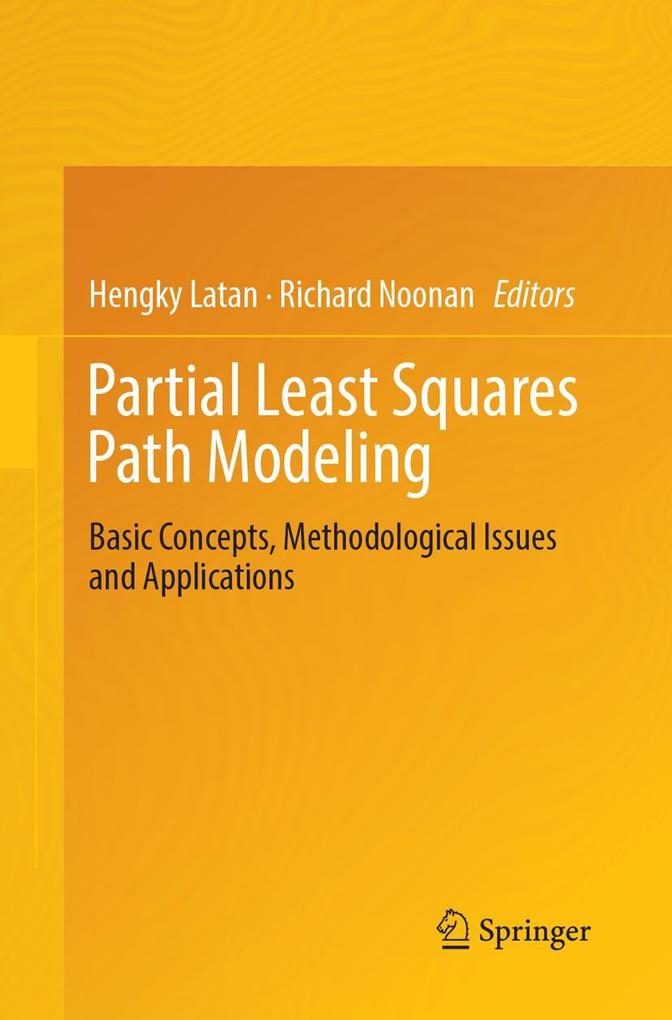
Zustellung: Fr, 13.06. - Mo, 16.06.
Versand in 2 Tagen
VersandkostenfreiBestellen & in Filiale abholen:
This edited book presents the recent developments in partial least squares-path modeling (PLS-PM) and provides a comprehensive overview of the current state of the most advanced research related to PLS-PM. The first section of this book emphasizes the basic concepts and extensions of the PLS-PM method. The second section discusses the methodological issues that are the focus of the recent development of the PLS-PM method. The third part discusses the real world application of the PLS-PM method in various disciplines. The contributions from expert authors in the field of PLS focus on topics such as the factor-based PLS-PM, the perfect match between a model and a mode, quantile composite-based path modeling (QC-PM), ordinal consistent partial least squares (OrdPLSc), non-symmetrical composite-based path modeling (NSCPM), modern view for mediation analysis in PLS-PM, a multi-method approach for identifying and treating unobserved heterogeneity, multigroup analysis (PLS-MGA), the assessment of the common method bias, non-metric PLS with categorical indicators, evaluation of the efficiency and accuracy of model misspecification and bootstrap parameter recovery in PLS-PM, CB-SEM, and the Bollen-Stine methods and importance-performance map analysis (IPMA) for nonlinear relationships. This book will be useful for researchers and practitioners interested in the latest advances in PLS-PM as well as master and Ph. D. students in a variety of disciplines using the PLS-PM method for their projects.
Inhaltsverzeichnis
Dedication. - Foreword. - Preface. - Table of Contents. - Part I: Basic Concepts and Extensions. - Partial Least Squares: The Gestation Period (Richard Noonan). - Partial Least Squares Path Modeling: Updated Guidelines (Jörg Henseler, Geoffrey Hubona, and Pauline Ash Ray). - Going Beyond Composites: Conducting a Factor-Based PLS-SEM Analysis (Ned Kock). - The Perfect Match between a Model and a Mode (Theo K. Dijkstra). - Quantile Composite-Based Model: A Recent Advance in PLS-PM (Cristina Davino, Pasquale Dolce, and Stefania Taralli). - Ordinal Consistent Partial Least Squares (Florian Schuberth and Gabriele Cantaluppi). - Part II: Methodological Issues. - Predictive Path Modeling through PLS and Other Component-Based Approaches: Methodological Issues and Performance Evaluation (Pasquale Dolce, Vincenzo Esposito Vinzi, and Carlo Lauro). - Mediation Analyses in Partial Least Squares Structural Equation Modeling: Guidelines and Empirical Examples (Gabriel Cepeda, Christian Nitzl, and Jose Luis Roldán). - Treating Unobserved Heterogeneity in PLS-SEM: A Multi-Method Approach (Marko Sarstedt, Christian M. Ringle, and Joe F. Hair). - Applying Multigroup Analysis in PLS-SEM: A Step-by-Step Process (Lucy Matthews). - Common Methods Bias: A Full Collinearity Assessment Method for PLS-SEM (Ned Kock). - Integrating Non-Metric Data in Partial Least Squares Path Models: Methods and Application (Francesca Petrarca, Giorgio Russolillo and Laura Trinchera). - Model Misspecifications and Bootstrap Parameter Recovery in PLS-SEM and CBSEM based Exploratory Modeling (Pratyush N. Sharma, Ryan Pohlig, and Kevin H. Kim). - Part III: Applications. - Personality, Intellectual Ability, and the Self-Concept of Gifted Children: An Application of PLS-SEM (R. Frank Falk). - Ethical Awareness, Ethical Judgment and Whistleblowing: A Moderated Mediation Analysis (Hengky Latan, Charbel Jose Chiappetta Jabbour and Ana Beatriz Lopes de Sousa Jabbour). - Latent Variable Regression for Laboratory Hyperspectral Images (Paul Geladi, Hans Grahn, and Kim H. Esbensen). - Dealing with Nonlinearity in Importance-Performance Map Analysis (IPMA): An Integrative Framework in a PLS-SEM Context (Sandra Streukens, Sara Leroi-Werelds, and Kim Willems). - Appendix. - About the Authors. - Index.
Produktdetails
Erscheinungsdatum
31. August 2018
Sprache
englisch
Auflage
Softcover reprint of the original 1st edition 2017
Seitenanzahl
452
Herausgegeben von
Hengky Latan, Richard Noonan
Verlag/Hersteller
Produktart
kartoniert
Abbildungen
XXXVII, 414 p. 112 illus., 37 illus. in color.
Gewicht
680 g
Größe (L/B/H)
235/155/25 mm
Sonstiges
Previously published in hardcover
ISBN
9783319877143
Entdecken Sie mehr
Bewertungen
0 Bewertungen
Es wurden noch keine Bewertungen abgegeben. Schreiben Sie die erste Bewertung zu "Partial Least Squares Path Modeling" und helfen Sie damit anderen bei der Kaufentscheidung.









